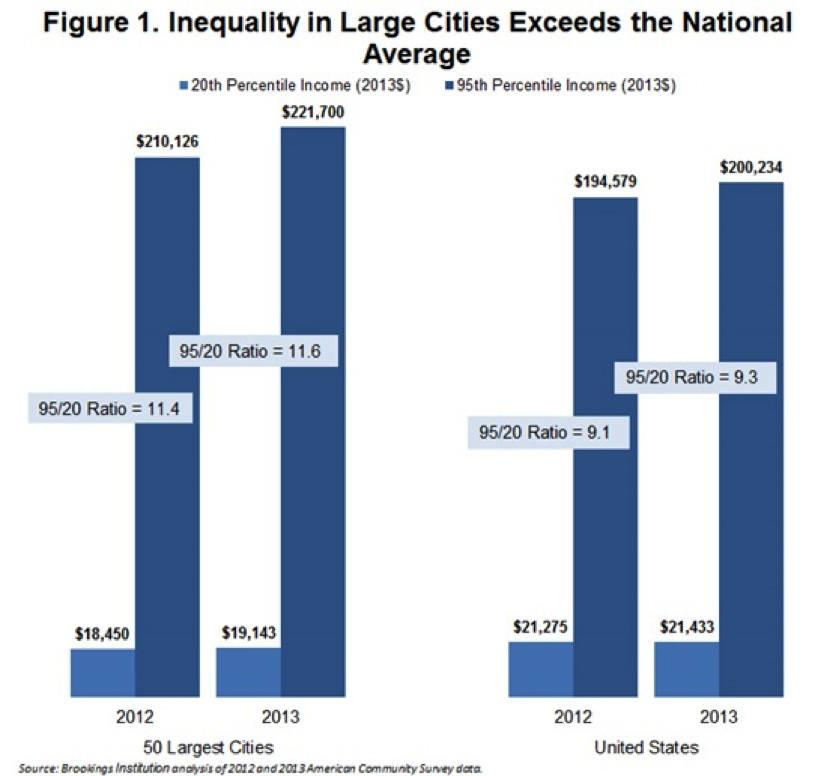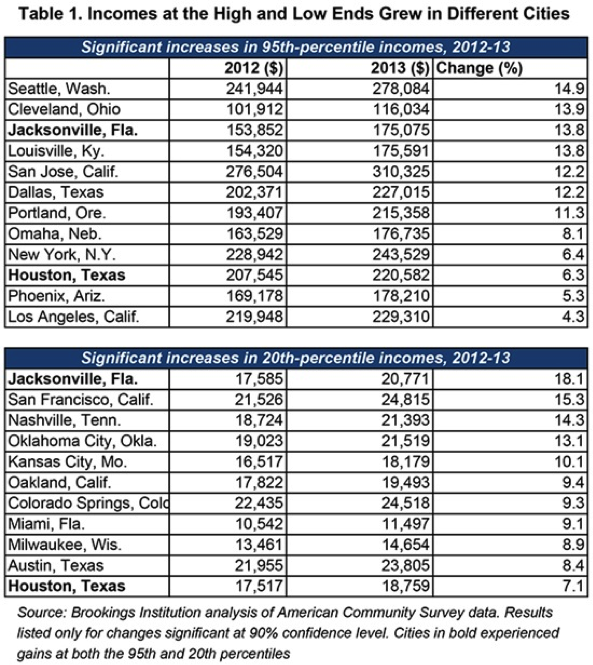Just in time for the budget debate on Capitol Hill, a new study by the Brookings Institution confirms that income inequality between the richest and lowest income residents of the 50 largest U.S. cities continues to grow.
The report – using data from the Census Bureau’s American Community Survey – asserts that more than five years after the end of the Great Recession and three years since the Occupy Wall Street movement, “high and growing levels of income inequality continue to animate debates on politics and public policy.”
Related: Why Americans Shrug Off Income Inequality
Congress this week began debating controversial House and Senate GOP balanced budget plans to reduce the tax burden while cutting as much as $5.5 trillion in entitlement programs and other domestic spending in the next decade. GOP leaders say the cuts are critical in order to avert long-term deficits and spur economic growth. Democrats and President Obama, on the other hand, call the proposed cuts an assault on lower- and middle-income Americans that would undercut the recovery.
“In 2013,” says the Brookings study, “big cities continued to exhibit greater income disparities between rich and poor households than the rest of the country. Across the 50 largest cities, households in the 95th percentile of income earned 11.6 times as much as households at the 20th percentile.” That’s a much wider margin than 9.3, the national average ratio.
The report added, “This difference reflects the fact that in big cities the rich have higher incomes, and the poor lower incomes, than their counterparts nationally. From 2012 to 2013, the inequality ratio widened in both cities and the nation overall, as incomes at the top grew somewhat faster than incomes at the bottom. Notably, incomes grew faster for both the rich and poor in cities than they did elsewhere.”
What the report does not acknowledge is that young millennials are streaming into big cities in search of jobs and a compatible cultural experience. They are on the very low side of the earning scale. Additionally, the American Community Survey includes illegal immigrants who also cluster in big cities.
The Brookings study updates a 2014 analysis that examined levels of income inequality in 50 major cities. It also focused on trends between 2012 and 2013, the most recent data available from the U.S. Census Bureau.
Related: GOP Looks at Medicaid and Food Stamps for Overhaul
Several cities, including Seattle, Cleveland, Jacksonville (FL), Louisville, San Jose, Dallas and Portland witnessed dramatic growth in the incomes of their highest-earning households between 2012 and 2013. Seattle topped the list with 15 percent growth in income among those households, equivalent to a $36,000 increase.
Jacksonville, somewhat ironically, also led the list of cities that showed the greatest growth in the 20th percentile income level – followed by San Francisco, Oklahoma City, Kansas, Missouri, and Oakland. The estimated rate of income growth for rich households in San Francisco topped 18 percent, equal to a $66,000 increase.
Berube is a senior fellow and deputy director of the Brookings Metropolitan Policy Programs. Holmes is a senior research assistant at the Metropolitan Policy Program.
These two charts sum up the researchers’ findings:


Top Reads from The Fiscal Times:





